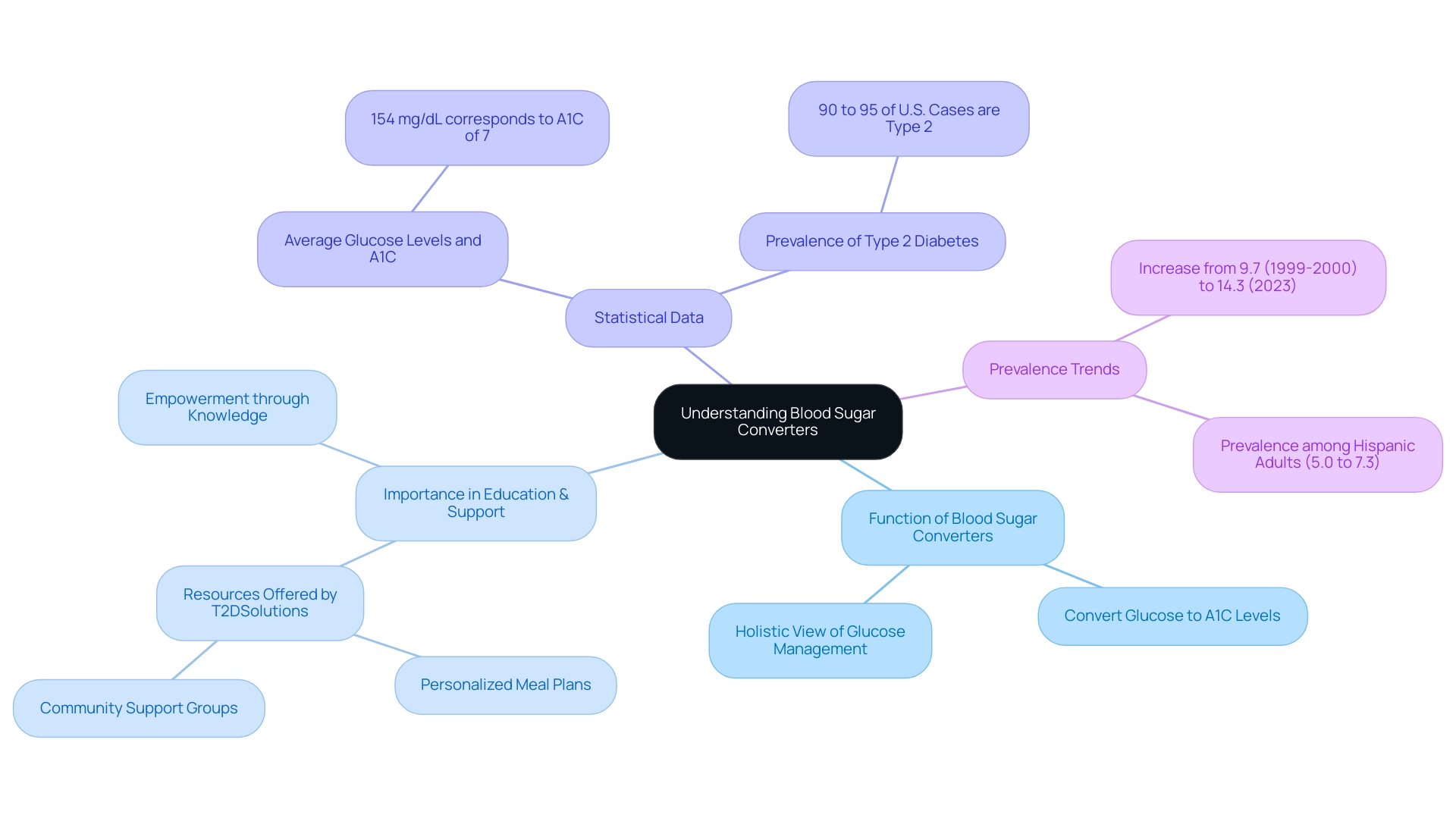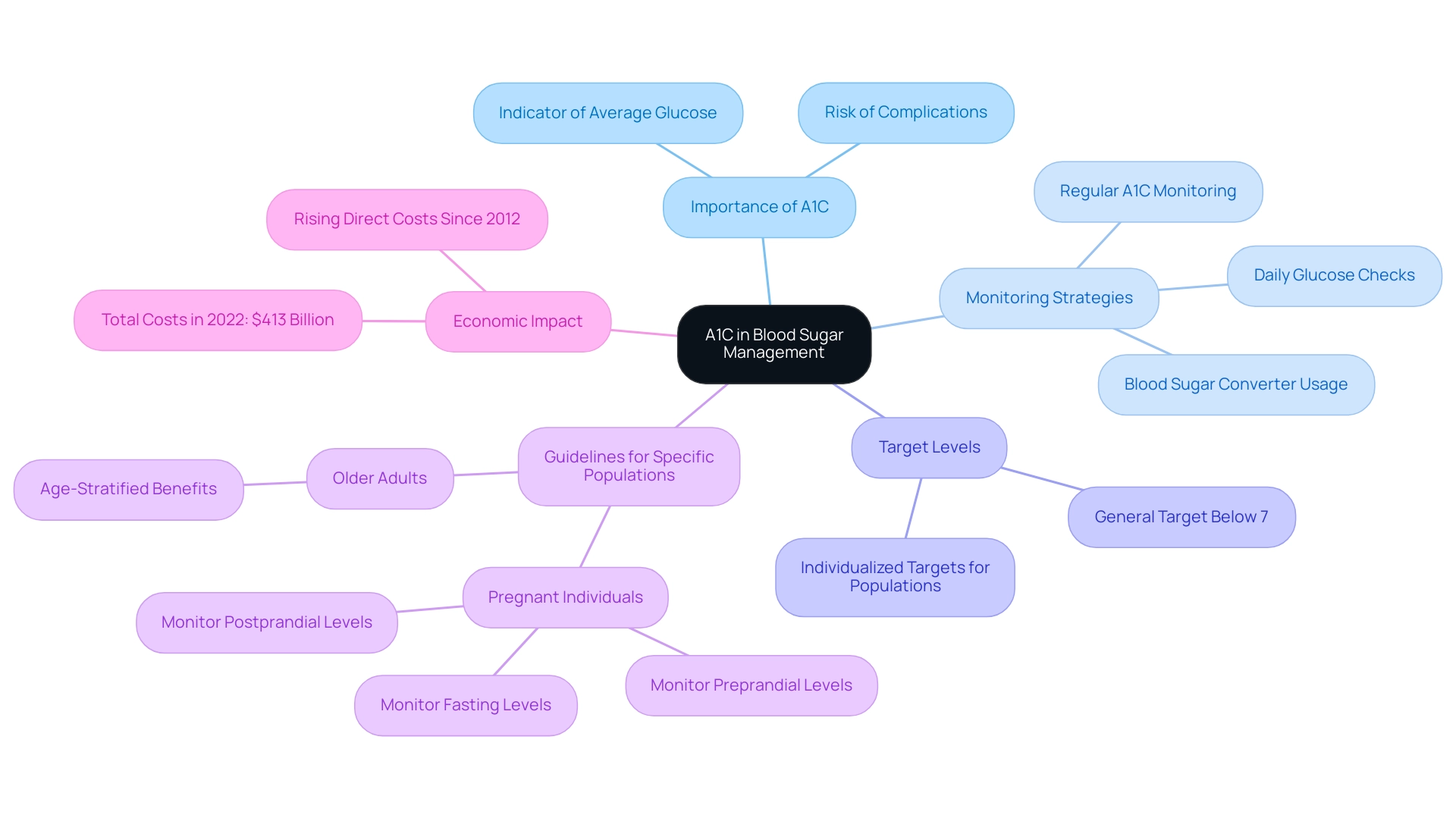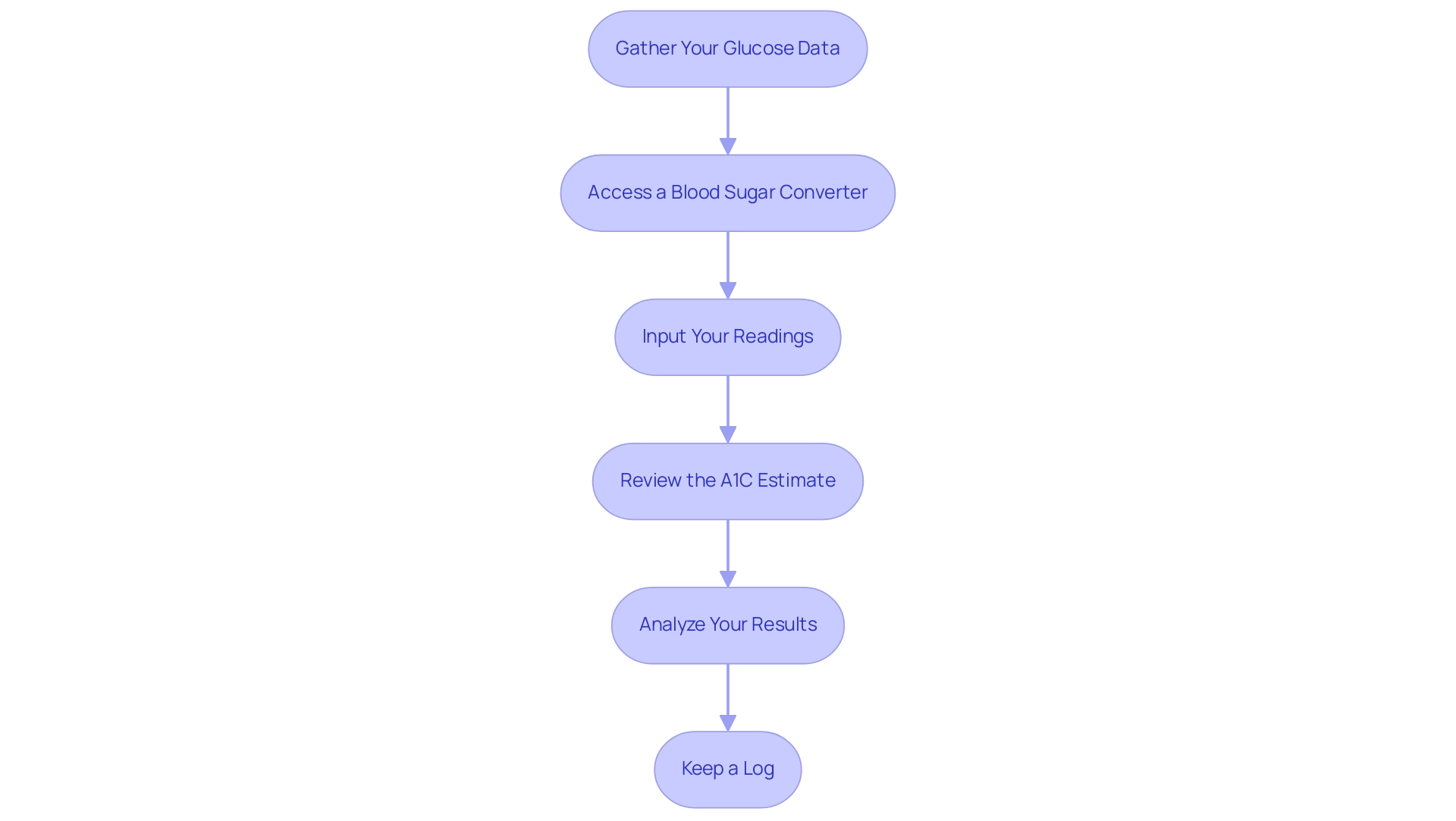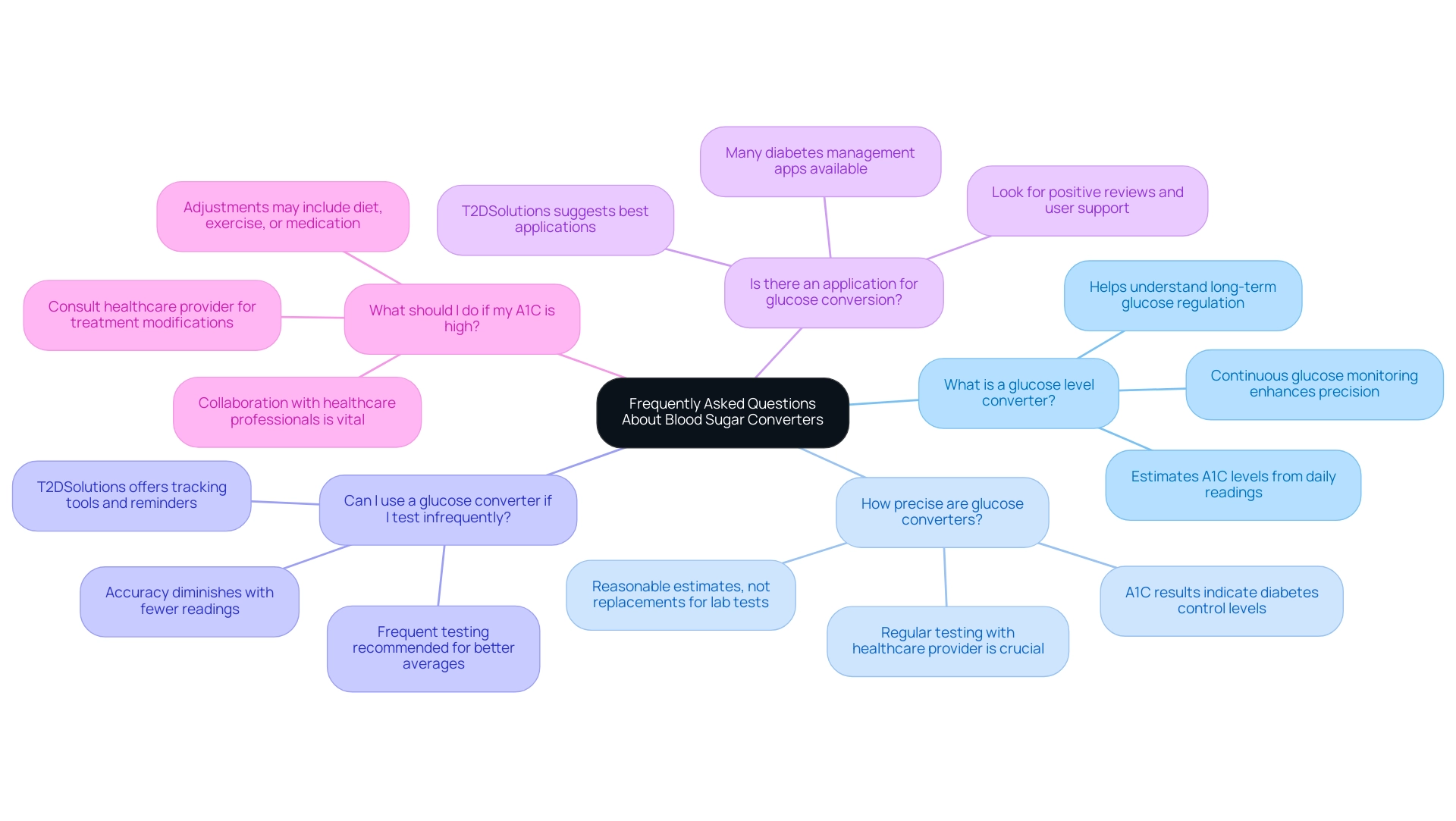Overview
The article provides a step-by-step guide on how to effectively use a blood sugar converter for managing diabetes by converting glucose readings into estimated A1C levels. This guide is supported by the article's detailed instructions on gathering data, using reliable tools, and analyzing results, which empower individuals to make informed decisions about their health management.
Introduction
In the realm of diabetes management, understanding the nuances of blood sugar levels is crucial for achieving optimal health. With the launch of T2DSolutions, a dedicated hub for Type 2 and Type 3 diabetes education, individuals are empowered to navigate their condition more effectively.
Central to this journey is the concept of blood sugar converters—tools that translate daily glucose readings into estimated A1C levels, providing insight into long-term blood sugar control.
As diabetes prevalence continues to rise, particularly among diverse populations, the importance of consistent monitoring and informed decision-making cannot be overstated.
Through a combination of educational resources and community support, T2DSolutions aims to equip patients with the knowledge and tools necessary to take charge of their diabetes management, fostering a proactive approach to health and well-being.
Understanding Blood Sugar Converters: An Overview
As part of the launch of Td Solutions, a comprehensive resource hub dedicated to Type 2 and Type 3 glucose education and community support, we emphasize the significance of the blood sugar converter. These crucial instruments act as a blood sugar converter, allowing people overseeing their condition to convert their glucose readings into estimated A1C levels, which indicate long-term sugar control. Utilizing standardized formulas, the blood sugar converter provides a holistic view of a patient’s glucose management, empowering newly diagnosed patients to understand their condition better.
For instance, research shows that an average glucose level of 154 mg/dL corresponds to an A1C of approximately 7%, equipping patients with knowledge to make informed dietary choices and medication adjustments. In light of recent statistics from the Centers for Disease Control and Prevention, which indicate that 90% to 95% of cases of this condition in the U.S. are Type 2, consistent blood glucose monitoring becomes crucial in managing this prevalent issue. Moreover, the prevalence of this condition among Hispanic, Latino, or Spanish adults highlights the necessity for targeted management strategies in diverse populations.
T2DSolutions aims to support individuals through education and resources, including personalized meal plans and access to community support groups, addressing the growing health concern related to blood sugar management as evidenced by an increase in prevalence from 9.7% in 1999-2000 to 14.3% by 2023. A recent review from a user indicates, 'Utilizing the blood sugar converter has changed my comprehension of my condition management, enabling me to make improved decisions daily.' By utilizing a blood sugar converter along with the resources offered by t2d solutions, patients can take proactive steps towards better health outcomes.

The Role of A1C in Blood Sugar Management
A1C, or glycated hemoglobin, serves as a crucial indicator of average blood glucose levels over the preceding two to three months, making it an essential measurement that can be analyzed with a blood sugar converter. As T2DSolutions launches as a comprehensive resource hub for Type 2 and Type 3 conditions education and community support, understanding A1C is vital for newly diagnosed patients. Healthcare providers utilize A1C levels to evaluate the effectiveness of treatment regimens, with a target generally set below 7% for most adults with the condition, reflecting a reduced risk of complications.
Regular monitoring of A1C, along with daily glucose checks and utilizing a blood sugar converter, offers a thorough perspective on management, enabling prompt modifications to care plans. Current research highlights the importance of maintaining optimal A1C levels, especially in older adults, where findings from the Look AHEAD trial reveal comparable benefits from tight glycemic control across age groups. Furthermore, the latest guidelines from the American Diabetes Association emphasize individualized A1C targets for various populations.
For instance, pregnant individuals with high blood sugar are advised to closely monitor their fasting, preprandial, and postprandial blood glucose levels. With the economic costs of managing this condition reaching $413 billion in the U.S. in 2022, effective strategies, including vigilant A1C monitoring, are crucial to mitigate this burden and enhance patient outcomes. T2DSolutions aims to equip patients with the necessary tools and knowledge to manage their condition effectively.
As we continue to develop our resources, we encourage you to subscribe for updates so you can stay informed about new content that will support your health management journey.

Step-by-Step Guide to Using a Blood Sugar Converter
-
Gather Your Glucose Data: Begin by collecting your glucose readings from the past few weeks. Having a comprehensive set of data is crucial for accurate conversion and monitoring your health. This foundational step aligns with the support you can expect from T2DSolutions, your new resource hub for managing your condition.
-
Access a Blood Sugar Converter: Utilize online tools or reputable mobile applications designed for managing sugar levels, such as Diabetes: M or Glooko, which function as effective blood sugar converters. These tools not only provide conversions but also allow you to log food and activity, enhancing your overall management strategy. Notably, these apps have an average rating of 4.5 stars in the App Store and Google Play, reflecting their reliability and user satisfaction. T2DSolutions will offer advice on utilizing these resources effectively and will showcase educational articles and videos to assist you in understanding how to manage your condition more effectively.
-
Input Your Readings: Carefully enter your glucose readings into the converter. Many tools will allow you to input multiple readings to compute an average, which can lead to a more accurate A1C estimate.
-
Review the A1C Estimate: After entering your data, the blood sugar converter will provide an estimated A1C level. This number reflects your average glucose regulation and is a crucial metric in managing your diabetes effectively. T2DSolutions will offer comprehensive charts and tools to assist in this process, including interactive graphs that track your progress over time.
-
Analyze Your Results: Compare your estimated A1C with your target range. If your estimate exceeds your target, it may be beneficial to consult with your healthcare provider about possible adjustments to your management plan to optimize your health. T2DSolutions aims to empower you with the knowledge to make these informed decisions. For instance, one user shared, "T2DSolutions helped me understand my numbers better, and I feel more confident discussing my health with my doctor."
-
Keep a Log: Regularly document your glucose readings and A1C estimates. Maintaining this log is invaluable for tracking your progress and can provide essential information during consultations with your healthcare team. For instance, Glooko allows users to sync data from blood sugar meters and provides insights into blood sugar patterns, assisting healthcare professionals in making informed treatment decisions. Emilia Brzozowska highlights the significance of these resources, stating,
We want to help others uncover as many valuable tools as possible for managing their condition.
By following these steps and utilizing reliable tools, you can take charge of your diabetes management, supported by T2DSolutions as your comprehensive resource for Type 2 and Type 3 diabetes education.

Frequently Asked Questions About Blood Sugar Converters
-
What is a glucose level converter?
A blood sugar converter is a valuable tool designed to estimate your A1C levels based on your daily blood glucose readings. This assessment helps in comprehending your long-term glucose regulation, offering insights into your overall health management. With advancements in technology, continuous glucose monitoring (CGM) systems are accessible, which can further improve the precision of these estimates by offering real-time information on glucose variations.
T2DSolutions aims to be your go-to resource for utilizing such tools effectively as part of your diabetes management journey, offering educational articles, interactive tools, and community support tailored to your needs.
-
How precise are glucose converters?
While blood sugar converters can offer a reasonable estimate of your A1C levels, they are not a replacement for laboratory A1C tests. Regular testing with your healthcare provider is crucial for accurate monitoring and management of your condition. A case study on interpreting HbA1c results highlights how these results are reported as a percentage, indicating varying levels of diabetes control: normal, prediabetes, and diabetes.
This underscores the importance of personalized guidance from healthcare professionals based on individual medical history and health. For newly diagnosed patients, T2D Solutions provides resources, community support, and testimonials to help navigate these important discussions with your healthcare provider.
-
Can I use a glucose converter if I test infrequently?
You can use a blood sugar converter even if you test infrequently; however, the accuracy of the conversion may diminish with fewer readings. Frequent testing—ideally every three months, particularly for newly diagnosed patients or those undergoing significant treatment changes—provides a more accurate average for conversion, leading to better management decisions. T2DSolutions encourages regular monitoring and offers tips, such as personalized tracking tools and reminders, to help you establish a routine that suits your needs.
-
Is there an application for glucose conversion?
Numerous diabetes management apps feature blood sugar conversion tools. When selecting an app, it is advisable to look for those that have received positive reviews and offer robust user support. User satisfaction ratings can provide insight into the effectiveness and reliability of these apps, ensuring a better experience in managing your condition.
T2DSolutions will offer suggestions for the best applications, along with user testimonials, to assist you in maintaining your health management.
-
What should I do if my A1C is high?
If your A1C results are elevated, it is essential to consult with your healthcare provider. They can help you discuss potential modifications to your treatment plan, which may include adjustments to diet, exercise, or medication. As Dr. Howard Zisser emphasizes, "collaboration with healthcare professionals is vital for achieving optimal health outcomes," making it crucial to work closely with your provider to address any concerns regarding elevated A1C levels.
T2DSolutions will also feature articles, community forums, and success stories to help you connect with others and share strategies for improving your A1C levels.

Enhancing Diabetes Management Through Regular Monitoring
Consistent monitoring of glucose levels and A1C plays a pivotal role in enhancing diabetes management. By consistently monitoring these essential metrics, individuals can reveal patterns in their glucose reactions, effectively identifying how various foods and activities affect their levels. T2DSolutions is prepared to assist recently diagnosed patients by offering comprehensive blood sugar converter charts, which serve as vital resources for understanding and managing their glucose levels.
For instance, these charts can help individuals identify how specific meals affect their glucose responses, allowing for informed adjustments to dietary choices or medication dosages. This proactive approach not only aids in maintaining glucose levels within the optimal range—defined as 70–180 mg/dL—but also empowers individuals to take charge of their health. As emphasized in the DIAMOND study, which assessed the effects of continuous glucose monitoring (CGM) on quality of life among adults with type 1 conditions, significant improvements were noted in condition-specific quality of life measures.
The study compared CGM to self-monitoring of blood glucose (SMBG) in 158 adults with poorly controlled T1D, revealing that while CGM users reported reduced distress related to the condition and increased confidence in managing hypoglycemia, no significant changes were observed in non-condition-specific quality of life measures. This kind of accountability fosters a greater sense of control over one’s health, ultimately leading to enhanced long-term outcomes and lowering the risk of diabetes-related complications. With T2D Solutions, we aim to provide resources and community support to reinforce the importance of such self-care behaviors.
Future research is recommended to validate these findings and explore the broader impact of CGM devices in real-world clinical settings. As Kolb L. emphasizes, an effective model of diabetes care and education can be achieved through the adoption of self-care behaviors, underscoring the vital role of regular monitoring in the management of diabetes.

Conclusion
Utilizing blood sugar converters and understanding A1C levels are essential components of effective diabetes management. T2DSolutions serves as a vital resource, offering education and tools that empower individuals to translate their daily glucose readings into meaningful insights about their long-term health. By enabling users to monitor their blood glucose levels consistently, T2DSolutions encourages a proactive approach to managing diabetes, helping to mitigate the rising prevalence of this condition, especially among diverse populations.
The importance of regular monitoring cannot be overstated. By keeping track of blood glucose and A1C levels, patients can identify patterns and make informed adjustments to their diets and treatment plans. This level of self-awareness fosters a sense of control and confidence, ultimately leading to improved health outcomes and reduced risk of complications. T2DSolutions not only provides the necessary tools but also fosters a supportive community, ensuring that individuals feel equipped to navigate their diabetes journey.
In summary, the combination of educational resources, community support, and practical tools like blood sugar converters positions T2DSolutions as an indispensable ally in the quest for better diabetes management. Embracing these resources can lead to more informed decisions, improved health, and a better quality of life for those living with diabetes. Taking charge of one’s health is a journey, and with the right support, it is a journey that can lead to significant, positive change.



